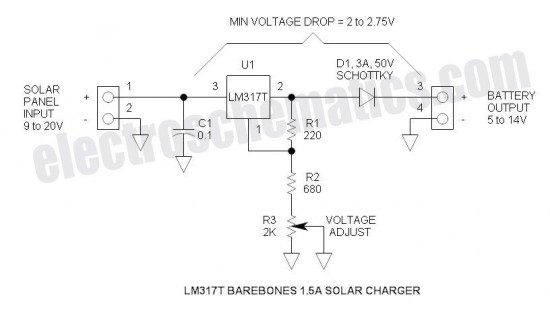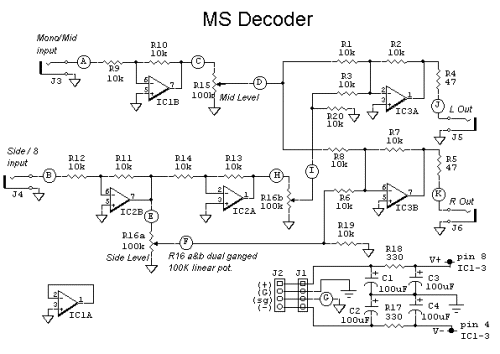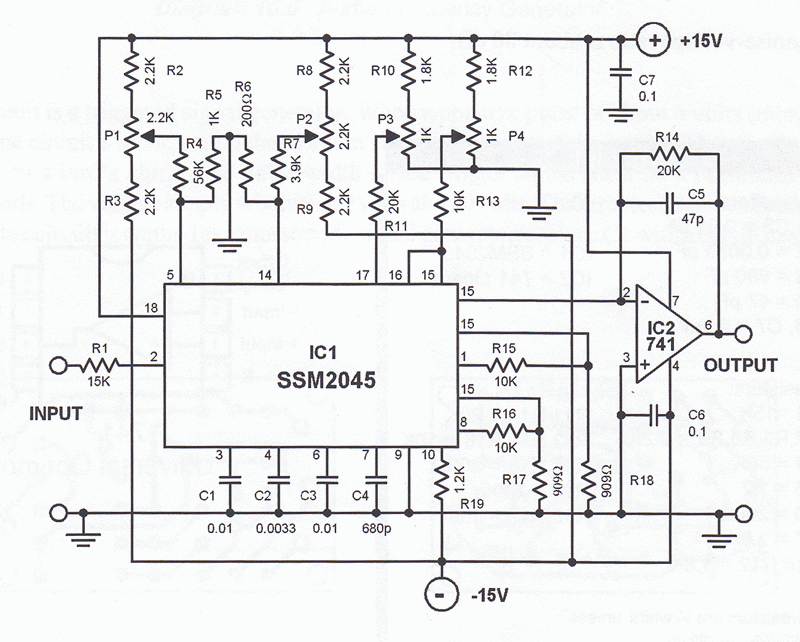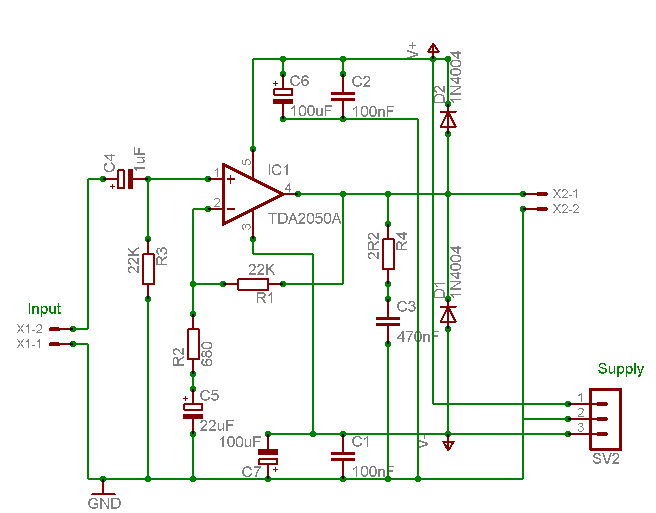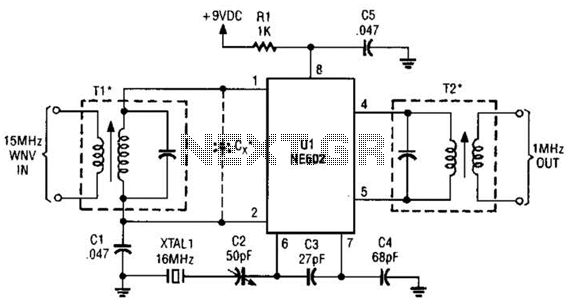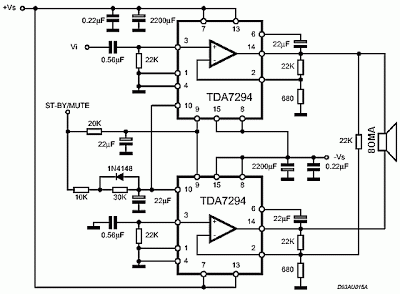
Super-Simple Shortwave Receiver Circuit
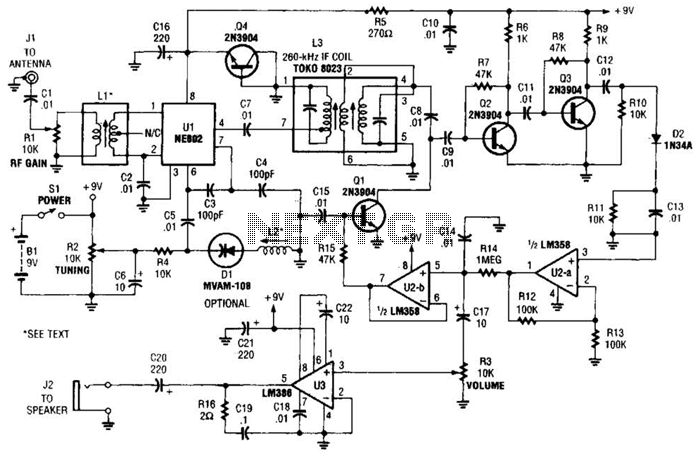
The integrated circuit Ul (an NE602 double-balanced mixer) functions as both an oscillator and a frequency mixer. Signals from the antenna input (at Jl) are transmitted through a DC-blocking capacitor C1 to the RF gain control, Rl, and subsequently to the input of Ul at pins 1 and 2. The local oscillator frequency, adjustable via R2 and L2, is mixed internally within Ul, producing an output. The mixer output at pin 4 of Ul is connected to a tunable 260-kHz band-pass intermediate frequency (IF) transformer, L3, through a DC-blocking capacitor C7. Consequently, signals that are approximately 260 kHz above and below the local oscillator frequency are allowed to pass, while others are effectively attenuated. The IF frequencies undergo amplification through transistors Q2 and Q3. The AM audio signal is extracted by D2 and its associated components, which eliminate the RF signals, leaving only the audio signals. These signals are preamplified by Ul-a (one half of an LM358 dual op-amp). The audio signal is subsequently amplified to speaker level by the LM386 low-voltage audio power amplifier, U3.
The NE602 integrated circuit serves as a versatile component in RF applications, particularly in communication systems where mixing and frequency conversion are essential. The circuit begins with the reception of RF signals via the antenna input at Jl. The DC-blocking capacitor C1 ensures that any DC component is removed from the incoming signal, protecting the subsequent stages from unwanted biasing effects. The RF gain control resistor Rl allows for adjustment of the gain of the incoming RF signal, enabling optimization of signal strength before it enters the mixer.
The local oscillator, which is critical for the mixing process, is determined by the settings of R2 and L2. The frequency generated here is mixed with the incoming RF signal in the NE602, producing an output that contains both the sum and difference frequencies of the input signals. The desired IF signal, centered around 260 kHz, is isolated using the band-pass transformer L3, which selectively allows the appropriate frequencies to pass while blocking others.
After the mixing stage, the IF signal is amplified by transistors Q2 and Q3, which serve to enhance the signal strength for further processing. The detection of the audio signal from the AM modulation is achieved through diode D2, which rectifies the AM signal, enabling the extraction of the audio component while filtering out the RF carrier frequency. This process is crucial for demodulating the signal for audio playback.
The preamplification stage utilizes Ul-a, a section of the LM358 dual op-amp, to boost the audio signal to a suitable level for driving the final audio amplifier. The LM386, a low-voltage audio power amplifier, is employed to further amplify the audio signal to a level adequate for driving speakers, ensuring that the output is loud enough for listening applications. This combination of components, from RF signal reception to audio amplification, illustrates a comprehensive approach to processing AM signals in electronic communication systems. Integrated circuit Ul (an NE602 double-balanced mixer) is a combination oscillator and frequency mixer. Signals from the antenna input (at Jl) are fed through dc-blocking capacitor C1 to the RF-gain control, Rl, and fed to the input of Ul at pins 1 and 2.
The local-oscillator frequency, which varies with the settings of R2 and L2, is mixed internally within Ul, resulting in an output. The mixer output at pin 4 of Ul is applied to a tunable 260-kHz band-pass intermediate-frequency (IF) transformer, L3, tlirough dc-blocking capacitor C7.
Therefore, signals that are roughly 260 kHz above and below the local-oscillator frequency are passed while others are effectively blocked. The IF frequencies are now amplified by Q2 and Q3. The AM audio signal is detected by D2 and its associated components, which bypass the RF signals, and leave only the audio signals.
The signals are preamplified by Ul -a (half of an LM358 dual op amp). The audio is then boosted to speaker level by the LM386 low-voltage audio power amplifier, U3. 🔗 External reference
The NE602 integrated circuit serves as a versatile component in RF applications, particularly in communication systems where mixing and frequency conversion are essential. The circuit begins with the reception of RF signals via the antenna input at Jl. The DC-blocking capacitor C1 ensures that any DC component is removed from the incoming signal, protecting the subsequent stages from unwanted biasing effects. The RF gain control resistor Rl allows for adjustment of the gain of the incoming RF signal, enabling optimization of signal strength before it enters the mixer.
The local oscillator, which is critical for the mixing process, is determined by the settings of R2 and L2. The frequency generated here is mixed with the incoming RF signal in the NE602, producing an output that contains both the sum and difference frequencies of the input signals. The desired IF signal, centered around 260 kHz, is isolated using the band-pass transformer L3, which selectively allows the appropriate frequencies to pass while blocking others.
After the mixing stage, the IF signal is amplified by transistors Q2 and Q3, which serve to enhance the signal strength for further processing. The detection of the audio signal from the AM modulation is achieved through diode D2, which rectifies the AM signal, enabling the extraction of the audio component while filtering out the RF carrier frequency. This process is crucial for demodulating the signal for audio playback.
The preamplification stage utilizes Ul-a, a section of the LM358 dual op-amp, to boost the audio signal to a suitable level for driving the final audio amplifier. The LM386, a low-voltage audio power amplifier, is employed to further amplify the audio signal to a level adequate for driving speakers, ensuring that the output is loud enough for listening applications. This combination of components, from RF signal reception to audio amplification, illustrates a comprehensive approach to processing AM signals in electronic communication systems. Integrated circuit Ul (an NE602 double-balanced mixer) is a combination oscillator and frequency mixer. Signals from the antenna input (at Jl) are fed through dc-blocking capacitor C1 to the RF-gain control, Rl, and fed to the input of Ul at pins 1 and 2.
The local-oscillator frequency, which varies with the settings of R2 and L2, is mixed internally within Ul, resulting in an output. The mixer output at pin 4 of Ul is applied to a tunable 260-kHz band-pass intermediate-frequency (IF) transformer, L3, tlirough dc-blocking capacitor C7.
Therefore, signals that are roughly 260 kHz above and below the local-oscillator frequency are passed while others are effectively blocked. The IF frequencies are now amplified by Q2 and Q3. The AM audio signal is detected by D2 and its associated components, which bypass the RF signals, and leave only the audio signals.
The signals are preamplified by Ul -a (half of an LM358 dual op amp). The audio is then boosted to speaker level by the LM386 low-voltage audio power amplifier, U3. 🔗 External reference
